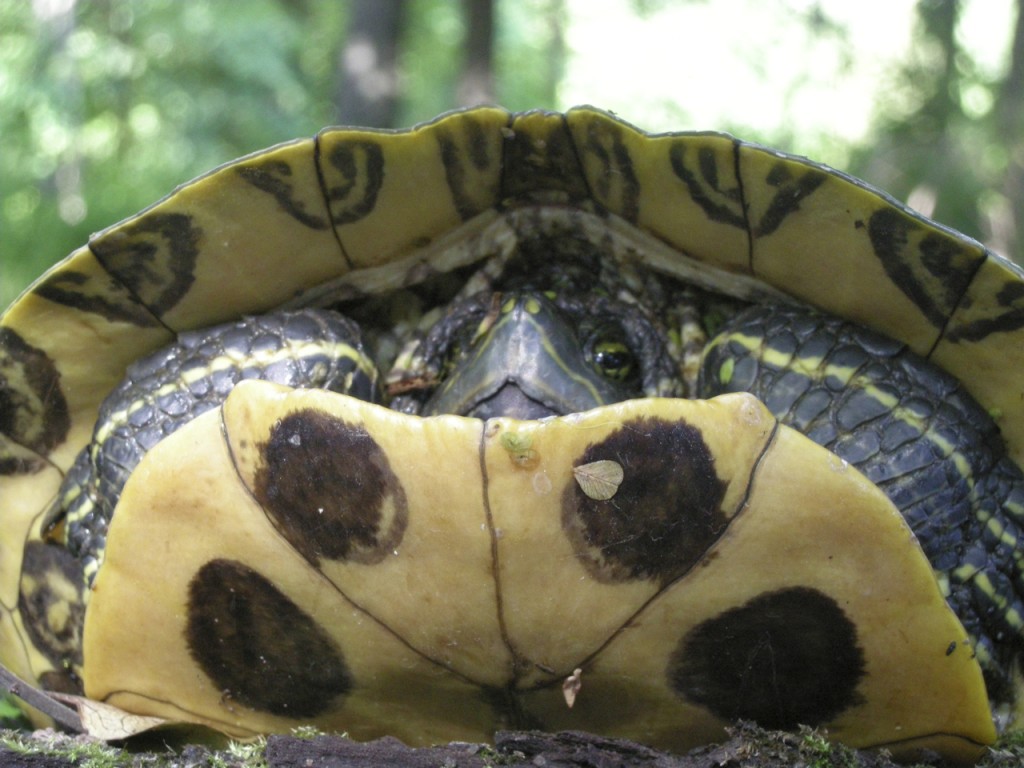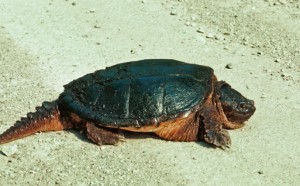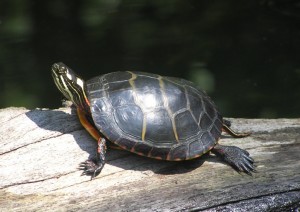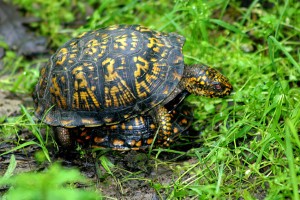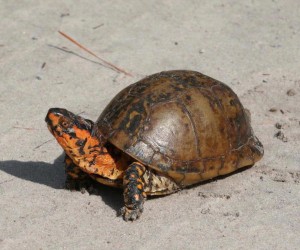Voice of the Turtle Heard in the Land
Turtles seem to have such detached insouciance — an armored implacability, an unsettling hold on life. They are the most ancient line of living reptiles, with fossilized specimens dated from over 250 million years ago.
Native Americans of the Eastern Woodlands, including the once-local Illini peoples, revered turtles, viewing them as representative of Great Turtle, a being responsible for the creation of all lands. In some Native Americans’ legends, Turtle appears as “Earth Diver,” the one being able to dive deeply enough and stay below long enough to carry up, clenched under his claw nails, a few crumbs of magical earth from the floor of the endless ocean. Once brought into the air, the magic earth grew and expanded to form all the lands. In other creation legends, additional water-dwelling animals help, but Great Turtle is assigned even more responsibility. Swans find and swim round the area of the sea where magical dirt can be found. Otter, Muskrat, Beaver, and Toad dive deeply, but are able to surface with only tiny bits of earth. They mound this on Great Turtle’s back, where it grows and increases to become the continent. In a twist — perhaps a pre-echo — of the modern geomorphological theory of plate tectonics, Native American peoples believed that land forms were fixed to the plates of Great Turtle’s shell.
Turtles’ species longevity and their individual long life span — 50 to 100 years among some of our local species — are attributable, in part, to their impregnable body structure, the shell. The upper shell, called a carapace, and lower shell, called a plastron, actually are expanded ribs and bones, seamed into plates, and covered in horny scales, which are called scutes. Many people divide the single order of turtles (Chelonia) into “life-style” groupings, calling freshwater dwelling turtles “terrapins” and land-dwelling turtles “tortoises.” Scientific classification schemes, however, divide turtles — animals with a carapace and plastron — not on lifestyle, but on the number and composition of the scutes.
Turtles are omnivorous. All eat plant materials and insects. Aquatic species also eat small fish and mammals, amphibians and snakes. Terrestrial turtles relish mushrooms and berries.
While turtles often are viewed as the very epitome of slowness, their loss of mobility came with the benefit of carrying their own fortress with them. Their armor-plating and ability to withdraw into their own defenses, however, are not the only reason the order has had such a long existence.
Living members of an ancient line, all reptiles were among the first vertebrates equipped with an advanced reproductive morphology, allowing internal fertilization of eggs, insuring greater reproductive success. Because soft tissue rarely is preserved in the fossil record — leaving unanswered the rather large question of how, exactly, dinosaurs reproduced — living reptiles are evidence that they were the first vertebrates to have, ahem, “naughty bits.” In an interesting turn, birds, which evolved from reptilian predecessors, generally do not have a phallus, excepting most ducks, swans, and geese. Of course, the reproductive structure is universal in mammals.
But whether, mammal, bird, or reptile, spring is, according to Judeo-Christian thought as told in the Song of Solomon, the season when: “….flowers appear on the earth; the time of the singing of birds is come, and the voice of the turtle is heard in our land.”
Whether or not we hear the turtles’ voices, they certainly now are about on the land. Monroe and Randolph Counties are home to eight kinds of turtles. Three taxa live mostly on the Bottoms, along the river and in wetlands and waterways of the flood way and flood plain. Five turtle species are common residents of our bluff lands. Each of our bluff’s species are breeding by May, and each has a distinctive courtship behavior.
Our common snapping turtles, large eight to 14-inch long turtles with big, pointy heads and long, thick, dragon-like, saw-toothed tails, live in numerous sink hole ponds. In water, they are quite docile; on land, however, they are very, very aggressive and can deliver a painful, though toothless, rasping bite.
At courtship time, a male and female snapper come onto land and face off, head to head. One moves its head sideways to the left and the other sideways to the right. And so they’ll sit, for hours, back and forth,
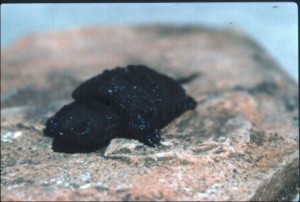
Scott Ballard, Illinois Department of Natural Resources. Note that this baby "snapper" still has its egg-tooth.
with heads alternating left-right, right-left. It seems a wonder their courtship works, because to us, they seem to be saying “No, I won’t,” and “No, neither will I.”
Painted turtles also are aquatic and live in sink hole ponds. They are our most common turtle and often can be seen basking on logs above the water. Three to seven inches long, their heads are colored in strong yellow lines and their necks, legs and feet sport orange and red linings.
Their courtship behavior also proceeds very slowly, but, rather than giving the appearance of an argument, is very genteel. The male painted turtle gently and repeatedly strokes the female’s face with his clawed front feet.
Red-eared sliders, our only other aquatic bluff land turtle, also enjoy basking sites in
and near sink hole ponds. Medium sized at five to eight inches long, they have a distinctive bright red patch on both sides of their head, just behind their eyes. In a courtship ritual similar to painted turtles, red-eared slider males gently stroke the females’ chin with the backside of a front foot.
Two species of terrestrial turtles live in our bluffs. Ornate box turtles, now
a very rare species in our area, live in open country, in prairies, grasslands, and glades. About five inches long, they have distinctive yellow lines radiating from the center of each scute of their high-domed carapace. Males court females by gently nipping on the edges of the females’ carapace.
Eastern box turtles are slightly smaller, four to five inches long, with a high-domed, olive-brown carapace that shows faint yellow-orange lines. They have bright orangish heads. They inhabit our oak-hickory forests and bask along brushy field edges. They may live well over 50 years. During courtship, the male draws close to a female, just inches away from her, arches up his head, and voices a slow, pulsating gurgle.
Once the “voice of the turtle” has been heard over the land, females of all of our local turtle species lay their eggs on dry land. The eggs are covered in a leather-like skin and are not hard-shelled like birds’ eggs. Females of each of the species may lay
several different clutches over the course of a summer. All dig shallow pits prior to laying their eggs and then cover them with dirt, using both sets of feet and their tails to both dig and then smooth over their nests.
Our aquatic species use some innovative engineering for nest building. Fresh water turtles have two large internal bladders, connected to their intestines, which aid in aquatic respiration by helping with osmotic oxygen exchange. If, during nesting, a female encounters only dried hard ground, she then will discharge bladder water to soften the job site and enable her to dig. She even will make several trips to a pond to ferry more water to her chosen site.
Some of our aquatic female turtles will travel great distances — up to a mile — from their watery home to their selected nesting sites. Snapping turtles have been known to slowly march for hours to find their perfect site. Her selection criteria remain largely unknown, but may have an impact on the next generation’s gender. The proportion of males to females among the hatchlings is determined by the temperature on the nest site. Warmer soil temperatures produce females, while cool temperatures result in male hatchlings.
Even as turtles concentrate on “location, location, location,” when nesting is complete, so, too, are their duties to their offspring. Once the eggs are laid and carefully covered they are abandoned. No parental care is given.
Depending on the species, the eggs hatch in two to four months. Some clutches, laid late in summer, will over winter before hatching after spring sunshine has re-warmed the nest site. In all cases, the hatchlings must fend for themselves, scrambling up out of the nest and setting off alone on their first journeys to find food and home sites.
Well over 80 percent of turtle eggs never make it to the hatching stage. Raccoons and opossums adore the eggs, scavenging widely during summer in search of them. The size of turtle egg clutches, from four to more than 30 eggs depending on the species, and the 2-3 clutches laid each year, may insure that new generations of an ancient animal line in our bluffs continue to ride on the island made possible by Great Turtle.
Clifftop, a local nonprofit organization, is focused on preserving and protecting area bluff lands.
A version of this article appeared in the May 7 2008 edition of the Monroe County Clarion.
© 2008 all content rights reserved, Clifftop NFP.
Comments are currently closed.

